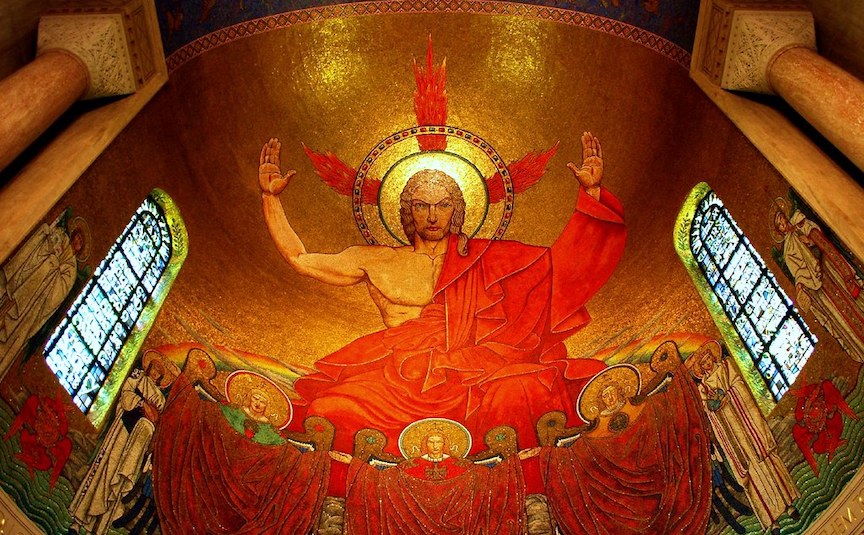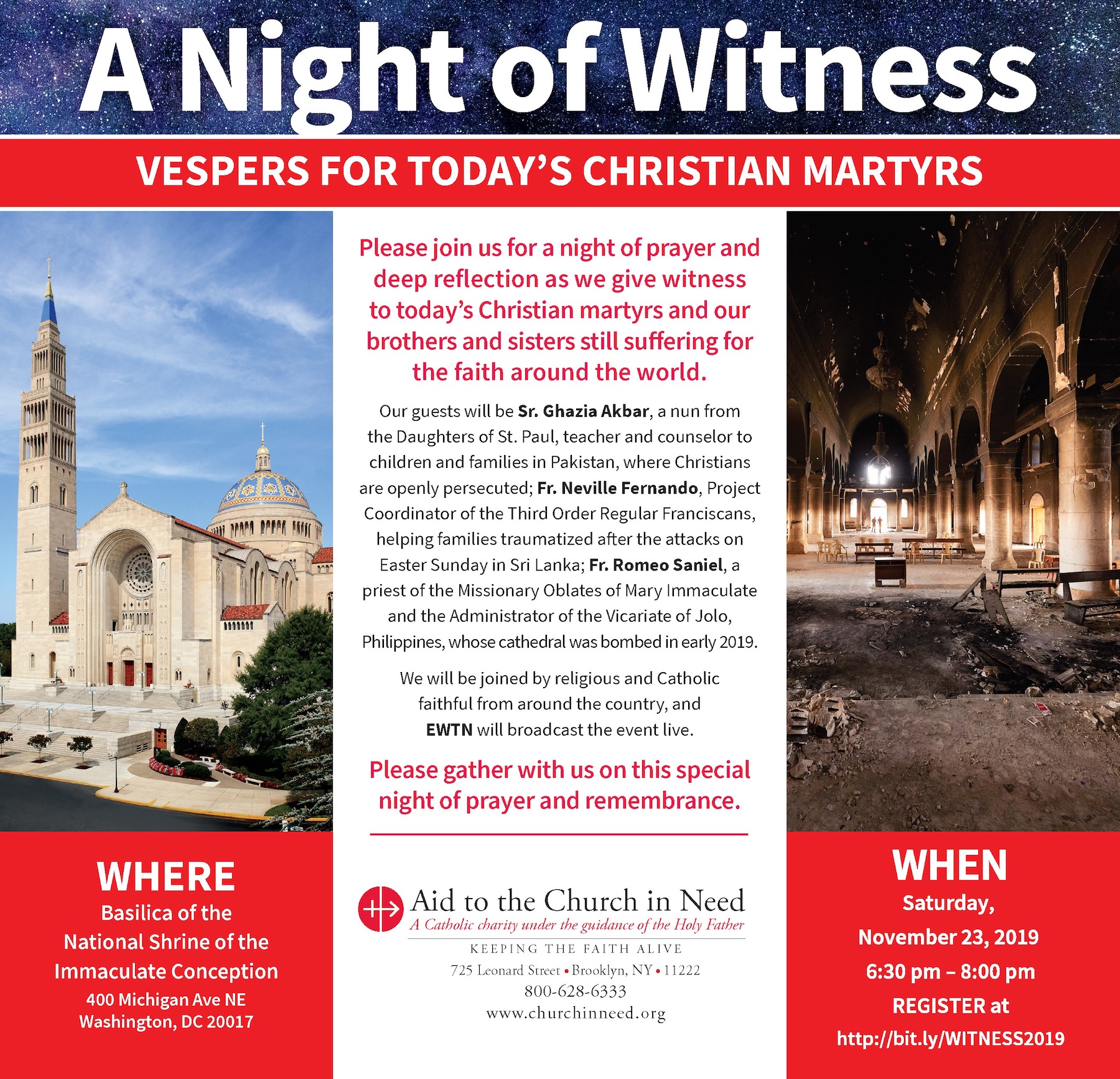Intimations of eternity are rare in this life. I had one, about this time of the year, when I was in high school. I’m enough of a modern man to know how unreal the claim seems. But it’s true. I was walking with a few friends under autumn leaves. We’d just been reading Virgil together in Latin, during last period. From somewhere, there welled up in me an overwhelming sense of both geologic ages and the immense extent of human life. And something beyond even those. Years later, I came upon an Italian poem – L’infinito – that captures the experience.
I had a similar experience this past Saturday morning. Archbishop Salvatore Cordileone of San Francisco celebrated an Extraordinary Form Latin “Mass of the Americas” at the Basilica of the Immaculate Conception in Washington, accompanied by the music of Frank La Rocca, whom the archbishop had commissioned for that purpose. You can watch it by clicking here.
But listening to the recording and even watching the video can’t even begin to convey what the Mass was like in the Basilica. To underscore just one element, Archbishop Cordileone celebrated the Mass on the main altar under the baldacchino, way at the back of the church (instead of the new altar closer to the congregation). That had a marvelous effect. At least for me.
When he and the concelebrants processed to the far altar, near the imposing mosaic of Jesus as Pantocrator (“Ruler of All”), it was as if they were going deep into the divine mysteries. And later, when the priests came forward to distribute Communion, it was as if they were bringing the Body and Blood to the congregation from the depths of God Himself.
Call this romantic illusion, if you will – though I don’t consider myself prone to that sort of thing. But that’s what the Mass of the Americas conveyed to, I think, more than one person Saturday. Liturgical formality, noble music, serene worship, and the basilica’s very architecture combined to produce that rare experience.
We used to have a lot of that in the liturgy. The Mass, consequently, often impressed non-Catholics, even anti-Catholics. In 1774, John Adams (both non- and anti-) famously wrote to his wife, Abigail, about a Mass at Philadelphia’s Old S. Mary’s: “Here is every Thing which can lay hold of the Eye, Ear and Imagination. Every Thing which can charm and bewitch the simple and ignorant. I wonder how Luther ever broke the spell.”
Adams wouldn’t have been so quick to reach for the old anti-Catholic slur about “the simple and ignorant” if he had been in the Basilica Saturday. And he wouldn’t have been so sure that the Protestant Reformation – now ailing and seemingly in terminal decline – had done away with real Catholicism.
Archbishop Cordileone had a brilliant insight in developing this Mass of the Americas (plural). He wanted an instance of real liturgical beauty. As he said in the homily, Catholicism teaches the Three Transcendentals: the Good, the True, and the Beautiful. Naturally, we seek to follow and extend the Good in various forms; we cannot do so properly, though, unless we know the Truth; and for most people the Truth has to be manifested, primarily through Beauty.

Archbishop Cordileone also wanted a Mass that would be rooted in both Americas, North and South. And that meant incorporating elements of the two great Marian traditions: Our Lady of Guadalupe, Patroness of Latin America, and Our Lady of the Immaculate Conception, Patroness of the United States.
There has been a lot of discussion in the Church recently about the old notion of “inculturation.” By the end of Amazon Synod last month, it had become a contentious term, primarily because the Vatican seemed to have chosen to promote a kind of inculturation that bent the Church in the direction of “indigenous spiritualities” more than drawing those indigenous beliefs into the fullness of Catholic truth and practice.
Frank La Rocca’s music struck a much better note of inculturation. The Mass was in Latin, Extraordinary Form, so the music drew appropriately from Church traditions of chant and polyphony, but also spoke a fluid and, above all, contemplative modern musical idiom.
One of the temptations of composers writing modern Masses is to draw attention to the music – and themselves. As Joseph Ratzinger often said, both before and after becoming pope, some sacred music seems more an opera or a concert than a Mass. La Rocca’s lovely work never gives into such temptations. Rather, it serves the spirit of the liturgy at every point.
There were Spanish and Indian motifs, particularly the melody of a popular hymn La Guadalupana woven into traditional musical forms, but never in a way that was intrusive or out of balance. While the archbishop was vesting publicly – quite something to witness in a pontifical Mass – the choir sang La Rocca’s beautiful arrangement of El Cantico del Alba (“The Song of the Dawn”), which contains the line: “Hell trembles three times at the sound of ‘Ave Maria.’”
At the de-vesting after Mass, a soprano sang the equally lovely Aue Maria (sic) – in Nahuatl, the native language in which Our Lady of Guadalupe addressed St. Juan Diego in her appearances on the hill of Tepeyac.
And it all ended with the familiar melody of the Salve Regina, sung in Latin but with La Rocca’s exquisite arrangement surrounding and advancing it.
The Mass of the Americas will be celebrated in other places here in the United States as well as in Mexico. If you have the chance, do yourself – your spiritual life – a great favor: make the effort to attend. Or see if you can bring it to your local cathedral.
My hope is not only that it will be repeated many times in the future, but that some of the aesthetic and spiritual possibilities it has opened up will also find their way into parish Masses – which desperately need fresh inspiration – all over our Hemisphere, and beyond.
*Image: The Christ Pantocrator mosaic by Jan Henryk de Rosen, Basilica of the Immaculate Conception, Washington, D.C.
Another forthcoming event at the Basilica:
















